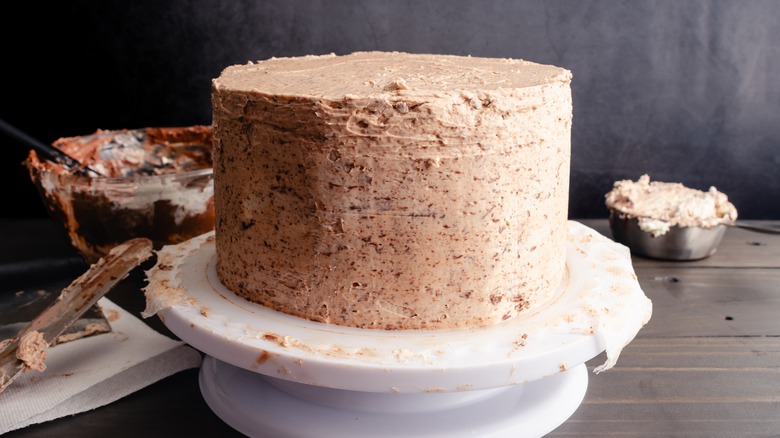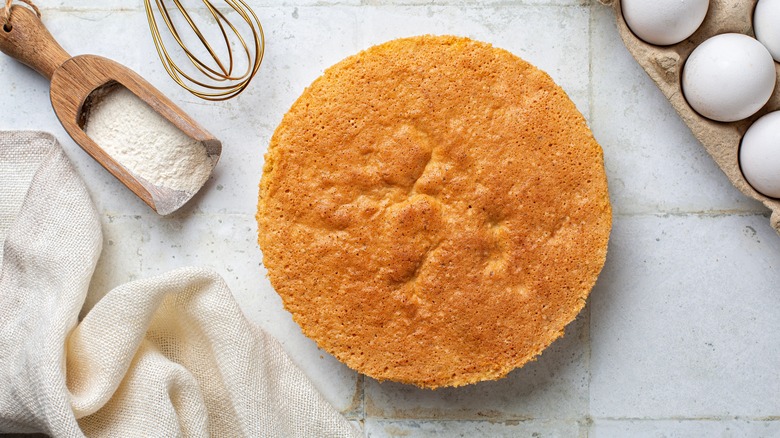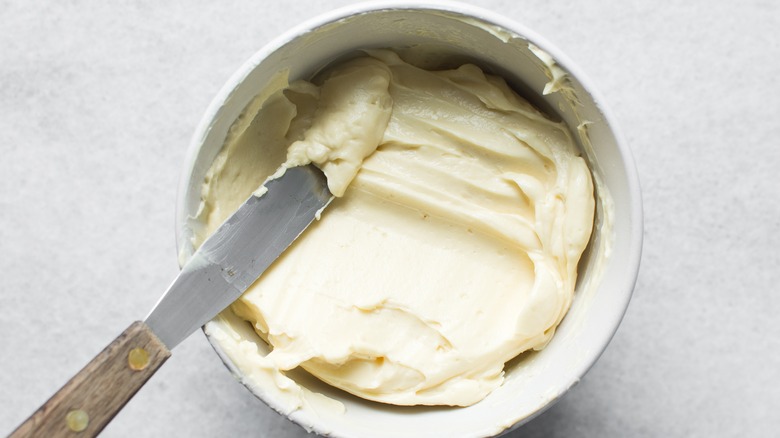What Exactly Does It Mean To Crumb Coat A Cake?
Sure, maybe you bake cakes a few times a year. Birthday cake? Check. Anniversary cake? Check. Emotional support cake? Check. While you may be happy with the cakes you do bake, maybe you've gotten lost on cake-baking TikTok and decided that this is the year that you take your hobby seriously.
There are plenty of tips and tricks to make the perfect moist cake (like making a grown-up olive oil cake with the right olive oil), but there may be one decorating technique you haven't heard of before: crumb coating. Crumb coating is the act of applying a thin layer of frosting to your cake and allowing it to chill before applying the real layer of decorative frosting. By crumb coating, you capture any loose crumbs and create a smooth surface to frost, pipe, and decorate to your heart's desire. You get the added bonus of locking in your cake's moisture, so you can make it in advance without it drying out. Think of the crumb coat as the primer for your actual frosting.
And the best part? It's super easy. So while it may add a bit of time to your baking, the results are totally worth it.
How to crumb coat a cake
After you've successfully avoided any cake-baking mistakes, level your layers off with a serrated knife and let them chill completely. If you frost them while they're warm — or even room temperature — it can cause your frosting to melt.
Gently brush excess crumbs off of your cake with a pastry brush, so you're left with as clean of a surface as possible. Then, frost the top of the bottom layer and place the next layer on top. Do this until your cake is successfully "glued" together. To crumb coat, use an offset spatula, take some frosting, and apply it to the sides and top of the cake. You want this layer to be thin. A good way to think about it is that you want to see your cake slightly through the icing. Once you've added the frosting, use a bench scraper flat against the cake and apply even pressure to remove any excess.
Whatever you do, don't add the excess crumb coat frosting back to your original frosting! It's now filled with itty bitty crumbs and will ruin your final look. Simply discard the excess or save it for your next batch of campfire s'mores cake pops.
Once done, let your crumb-coated cake get nice and cold before proceeding. The best way to do this is to put it in the freezer for 30 minutes or let it sit in the refrigerator overnight. Now, you'll have the ideal surface for a smooth, perfect finish.
The best frosting for a crumb coat
There are various kinds of frosting that work perfectly for a crumb coat, including buttercream and ganache. Buttercreams — whether French, Swiss, or Italian buttercream — are creamy and fluffy. This makes them perfect for creating a smooth crumb coat. Ganaches are thick and chocolatey and also work well for a crumb coat; however, they set just a tad faster than buttercream, which is nice when you're in a time crunch.
While you can usually use the same frosting for your decorative layer as you can for your crumb coat, this doesn't work when you're using certain things for your decorative layer, like royal icing or glazes.
Royal icing hardens significantly as it dries, and it dries fast, meaning you have to work at lightspeed. Instead, royal icing is best for decorative elements on the outside of a cake — and you may see it used often for painting sugar cookies. Glazes, on the other hand, are very sticky and runny, so they'll likely drip right off your cake and won't provide a sturdy surface for decorating. Another frosting that shouldn't be used as a crumb coat is fondant, which is an edible icing that's typically used to decorate and sculpt elements on a cake. Fondant dries out fast and becomes impossible to work with, and it generally needs a sticky surface to stick to a cake properly — like a crumb coat.



